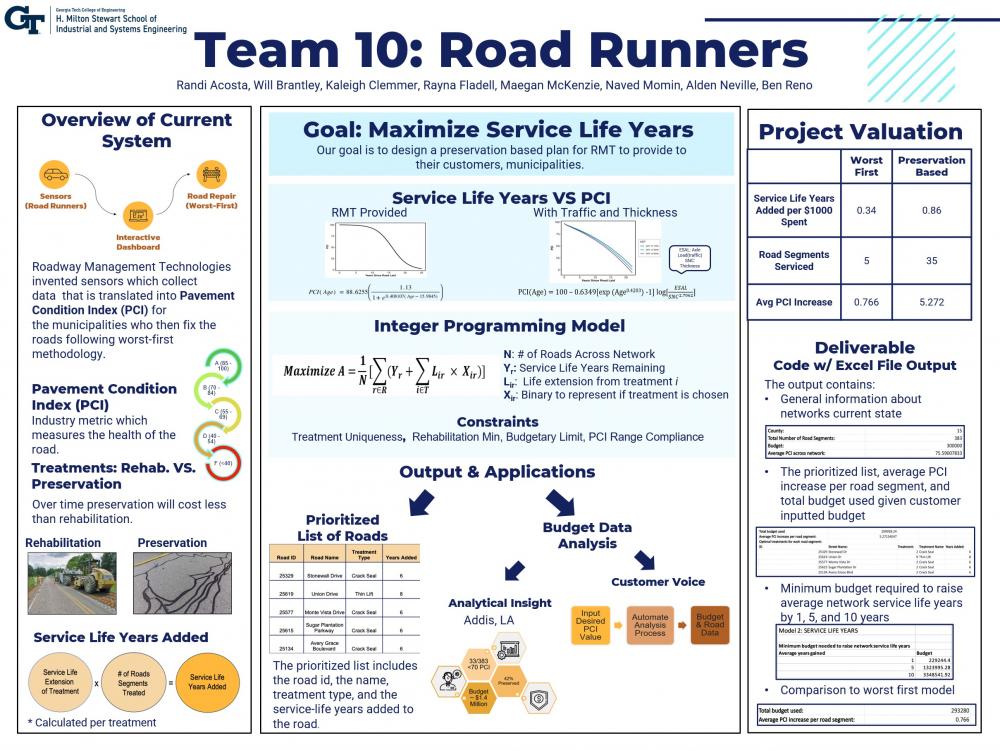Client Context
Roadway Management Technologies (RMT) was founded in 2018 to help streamline the process of road assessment and repair for their customers, municipalities, which are mostly rural small towns in the Southeast. RMT specializes in sensors, called Roadrunners, that are attached to the bottom of various public work vehicles; the sensors gather data on a road’s condition via regular vehicle routes by recognizing vibrations that could indicate poor pavement conditions or impurities like potholes. This data is utilized to calculate a road's Pavement Condition Index (PCI) score, an industry-standard metric representing road quality. These PCI scores are displayed on a map within the municipality's dashboard in real-time. The dashboards continually update the average PCI score for each road, providing RMT's customers with a snapshot of their road network's health to aid in road condition management. Currently, RMT only provides municipalities with the data collected on their roads, leaving the decision-making process for a repair plan in the municipality's hands. Municipalities may go about this process differently, with some having to pay third party contractors to decide on a plan, but most municipalities choose to implement a worst-first methodology, meaning they prioritize repairing the worst roads first, worst being the roads with the lowest PCI score based on RMT’s data.
Project Objective
There are 12 different road treatment types, each categorized under either rehabilitation or preservation. Rehabilitation is a more intense and expensive form of treatment that is applied to failing roads, while preservation treatments are reserved for roads with moderate PCI scores. The goal of preservation is to keep the road from deteriorating to the point where rehabilitation is the only option. Since rehabilitations are so costly, municipalities currently exercising the worst-first methodology allocate a large portion of their budget to treating relatively few roads in their network. Then, due to the rapid rate of road degradation, as the rehabilitated roads are repaired, the moderate roads start failing. The budget is therefore continuously allocated to these expensive repairs. However, if more of the fixed budget was assigned to preserving roads that are not yet the “worst” case, repair of the individual roads would cost less over time. With these savings, municipalities’ future budgets could be distributed among more roads, increasing the total service-life years added to the network. Service-life years refers to the anticipated duration of time that a road is expected to last before it is degraded down to a PCI score of 0.
Design Strategy
To help municipalities improve their overall road network health, the team is creating a preservation-based repair methodology that will maximize average service life years for a given road network. The team created an integer programming model designed to address a strategic mix of roads – some with the lowest PCI scores and some with moderate PCI scores – to incorporate preservation treatment types rather than focusing only on the most deteriorated roads. This will output a prioritized list of roads and the respective treatments that need to be applied, which is our Road Network Optimization Model.
The team also found opportunities to use similar logic in exploring the problem of municipal road repair budgets in a different perspective. Our analysis aims to determine the necessary budget to achieve a specific increase in the average service life years remaining per road segment in the network. It requires an input of the desired average increase in service life years and the costs associated with the twelve treatment options per square yard. The output from this model provides a projection of the average service life years gained per road segment, along with an estimation of the budget required to attain this increase across the network.
Deliverables
The team will send our python script to Roadway Management Technologies (RMT) for future usage. When RMT runs the code, an Excel file will be returned containing the output for the Prioritized Road Treatment model, the Minimum Budget Needed model, the Worst-First Model, and a graph related to the Prioritized Road Treatment model. This file can be presented to RMT’s clients to help them create their repair plan and analyze what more they can do by increasing their budget.
Value and Impact
The project valuation is based on the impact and value created for society by improving the utilization of taxpayer dollars; specifically, increasing the total road network service-life years for a given budget. We evaluated our preservation-based model against the worst-first model using the provided Addis dataset, our use case. This generated 2 lists of recommended roads for repair, treatment types, and added service life years. We then calculated the service life years adapted by each model and divided by the budget to obtain the metric: service life years added per thousand dollars spent. For testing purposes, we used a $300,000 budget, but RMT or municipalities can adjust this input to suit their budgetary requirements.
In our preservation-based IP model, the prioritization plan addresses 35 roads, contributing 258 service life years to the road network. Dividing 258 by 300,000 and then by 1000 yields 0.86 service life years added per $1000 spent. We apply the same method to the worst-first approach, which services 5 roads, resulting in 0.34 service life years added per $1000 spent. Moreover, the preservation-based model achieves an average PCI increase per road of approximately 5.272, compared to 0.766 in the worst-first method. These results underscore the effectiveness and efficiency of the preservation-based approach.


